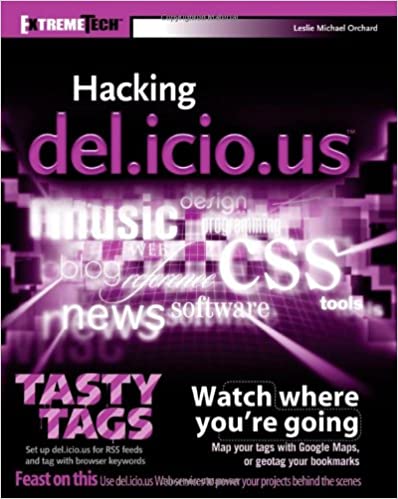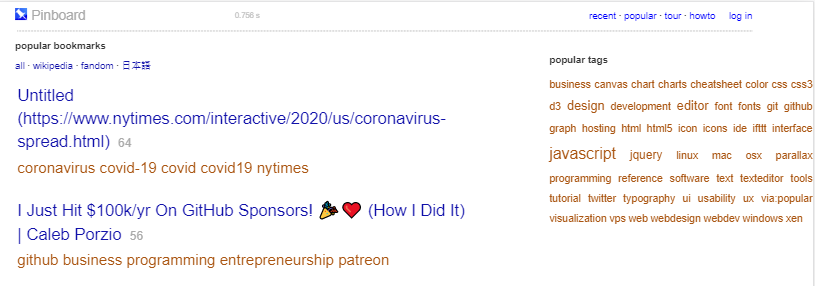When Leslie M. Orchard wrote Hacking del.icio.us in 2006 1, the del.icio.us 2 online bookmarking service was still a very popular and vibrant social bookmarking site.

how good was del.icio.us?
Some quotes from the book will remind us what del.icio.us was before talking about the pinboard.in bookmarking service available today. The author states in the book’s introduction:
Joshua Schachter invited me to try out del.icio.us in the latter half of 2003 (p. xv)
Until I read this book, I just thought del.icio.us was a weird domain name, but after trying it I agreed with the author’s next quote.
Joshua’s clean and well-considered incremental improvements got me hooked (p. xv)
The book’s readers gained a better understanding of how web developers were building the “Web 2.0” at that time.
Although the phrase “Web 2.0” has reached a cringe-worthy critical mass… del.icio.us is at the vanguard of what prompted the term (p. xv)
I myself had already done some JavaScript programming to improve the user interface experience on a few web sites. But while reading the book, I quickly learned so much more about open APIs, RSS and JSON feeds.
Convenient bookmarklets, XML data feeds, and the del.icio.us API…made… the service frictionless – and yet, counter-intuitively, these things made the site incredibly sticky. (p. xv)
So, Hacking del.icio.us gave me a new appreciation for using JSON to build dynamic web content based upon data supplied from dynamic data feeds, as well as learning all about social bookmarking and how ‘tags’ can help groups of people organize information on the web.
When Joshua introduced tagging features, the powers of social bookmarking really bloomed… del.icio.us morphed into a powerful hub for the aggregation and annotation of resources on the Web, filtered by the valuable attentions of real people. (p. xv)
The book itself offered so much more:
- clear examples of using CSS to improve page presentation;
- concise, powerful examples of JavaScript using JSON feeds;
- server-side programming examples using PHP and Python;
- many different examples of integrating bookmarks into blogs;
- and, lots of ideas for mashups using other web services.
del.icio.us…encouraged the growth of a rich ecosystem of Web- and desktop-based tools for managing, enhancing, and analyzing social bookmarks. (p. xv)
Why del.icio.us disappeared
But alas, del.icio.us would not last. It’s heyday has long since past. Yahoo acquired it in late 2005, and with the rise of mobile apps and social sites like Twitter, Facebook, and YouTube, people moved on to other types of web experiences. These users became the product that large corporations would fight to retain, and a “social bookmark manager” did not seem to do as well in this market. This is the point that Yahoo never seemed to understand, and perhaps mismanaged del.icio.us due to this misunderstanding.
Still, there were people who wanted to save bookmarks on the web and easily use and share those bookmarks in new and different ways. In 2009, Maciej Cegłowski,3 a former Yahoo employee, started Pinboard 4 because he wanted to make “a bookmarking website for introverted people in a hurry.” 5 In late 2010, when it leaked that Yahoo planned to “sunset” del.icio.us, many users switched over to Pinboard.
Despite what Maciej claims, Pinboard isn’t just “for introverts,” it offers an API and RSS and JSON feeds just like del.icio.us used to, and perhaps makes it easier to both share bookmarks and notes, as well as allowing users to keep whatever they want private. It is a paid service, which one could argue is actually better in the long run. Maciej says:
Because Pinboard is fully supported by user payments, the site will never show ads, and I will never share user data with third parties.
Loving Pinboard Today
Can we ever love Pinboard as much as we loved del.icio.us? Yes! and there are so many reasons why. You should take a look for yourself to answer that question. Pinboard is a very close fit for people who used del.icio.us way back when. You can get a visual impression of its interface by going to its list of popular or most recent public bookmarks posted by its users.

These links and some other pages are available to everyone. You don’t need an account to view them. Take some time and click on the tags, user names, and other links on these pages, and you may start to see what Pinboard can offer.
However, if you want to enjoy the full benefits of what Pinboard offers, you will need to sign up for an account and pay a subscription fee. You can do so at the following URL.
In future blog posts, I plan to cover more details about Pinboard and adapt sample code from the Hacking del.icio.us book for it.